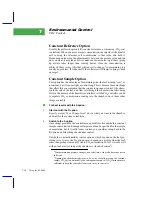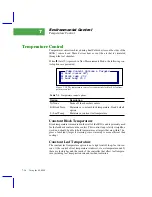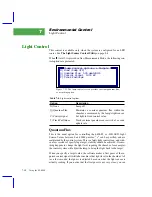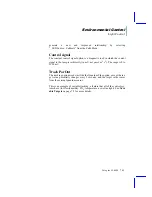
Light Sensor Considerations
Gallium Arsenide Phosphide (GaAsP) Sensor
Using the LI-6400
8-7
Temperature Effects
The LED sourceÕs efficiency and spectral characteristics depend a bit on tem-
perature. At 50C, the efficiency will be about 75% of what it is at 0C. This
means an increase in the power required for a given output (and a reduced
maximum output) at higher temperatures. The spectral shift is strongest for
the red LEDs. Typically, the peak wavelength is shifted towards longer wave-
lengths by 7 or 8 nm when comparing 0C to 50C performance. The blue peak
shifts up by only 2 nm over those temperatures.
Aging
Like all light sources, the LED source is subject to aging. We have had a
6400-02 running continuously since November 1995, and as of this writing
(25 months later), its output has dropped by 30%: (10% the first 6 months,
10% the second 6 months, and the 10% over the past 12 months).
If you find that your light source cannot achieve high enough light levels, and
you suspect itÕs simply due to the age of the source, then there is a possible
remedy. See
Gallium Arsenide Phosphide (GaAsP) Sensor
The spectral response of a GaAsP sensor is shown in Figure 8-4 on page 8-8,
along with the spectral response of an ideal quantum sensor for comparison.
The GaAsP sensor spectral response is similar to the ideal quantum sensor,
but it begins to drop dramatically at 650nm, the slope from blue to red is gen-
erally steeper than ideal, and itÕs nonlinear. While this is certainly not an ideal
quantum response, corrections for spectra of sources commonly encountered
in photosynthesis work can be made, and are usually less than ± 15%.
Mixed light sources will cause complications, but if one light source predom-
inates, the appropriate value for that source can be used, or the GaAsP sensor
can be calibrated to the specific lighting conditions using a LI-COR quantum
sensor (
Summary of Contents for LI-6400
Page 1: ...Using the LI 6400 Portable Photosynthesis System ...
Page 15: ...Part I The Basics ...
Page 16: ......
Page 174: ...Making Measurements Answers to Questions 4 56 Using the LI 6400 4 ...
Page 175: ...Part II Useful Details ...
Page 176: ......
Page 200: ...Standard Tools Power ON Hooks 5 24 Using the LI 6400 5 ...
Page 214: ...Real Time Data Real Time Graphics 6 14 Using the LI 6400 6 ...
Page 234: ...Environmental Control Light Control 7 20 Using the LI 6400 7 ...
Page 244: ...Light Sensor Considerations Gallium Arsenide Phosphide GaAsP Sensor 8 10 Using the LI 6400 8 ...
Page 288: ...Data Logging Making Your Own AutoPrograms 9 44 Using the LI 6400 9 ...
Page 289: ...Part III Working With Files ...
Page 290: ......
Page 312: ...The LPL File System Troubleshooting 10 22 Using the LI 6400 10 ...
Page 340: ...Downloading Files Using a Data Capture Program 11 28 Using the LI 6400 11 ...
Page 375: ...Part IV Configuration Issues ...
Page 376: ......
Page 420: ...Defining User Variables Old Style vs New Style 15 18 Using the LI 6400 15 ...
Page 454: ...Using an Energy Balance Further Reading 17 12 Using the LI 6400 17 ...
Page 455: ...Part V Maintenance Troubleshooting ...
Page 456: ......
Page 572: ...Troubleshooting Useful Information 20 46 Using the LI 6400 20 ...
Page 593: ...Part VI Programming ...
Page 594: ......
Page 622: ...Programming with LPL Compiler Directives 22 28 Using the LI 6400 22 ...
Page 846: ...Index I 16 Using the LI 6400 ...
















































